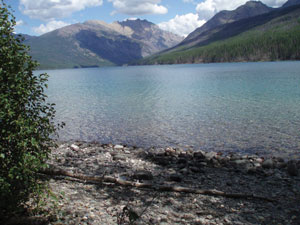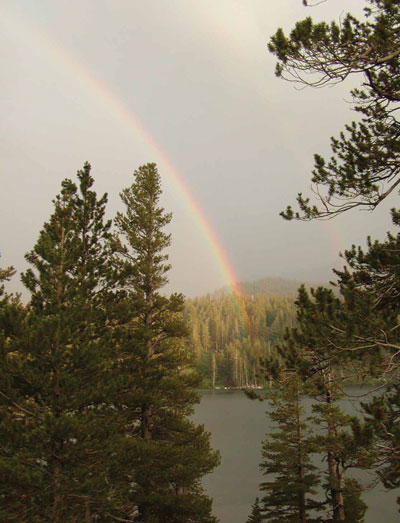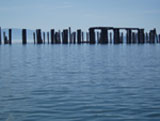Lakes
“A lake is the landscape’s most beautiful and expressive feature. It is earth’s eye;
looking into which the beholder measures the depth of his own nature.”
- Henry David Thoreau
There are hundreds of lakes throughout the Flathead Watershed—many of them deep, cold, and pristine glacial lakes. Waterton Lakes National Park has over 80 lakes and ponds. Upper Waterton Lake is the largest of the Waterton Lakes chain and one of the deepest lakes in the Rockies, at 483 feet (147 m). In Glacier National Park there are 762 lakes, of which only 131 are named. Glacier’s largest lake is Lake McDonald at 10 miles (16 km) long and 472 feet (143 m) deep. The larger lakes of Waterton and Glacier are fjord-like water bodies. These lakes fill ancient troughs that were carved by glaciers and dammed by hard rock layers or behind terminal moraines (glacial debris).
 |
Figure 4.2: Kintla Lake. Source: Lori Curtis |
 |
| Figure 4.3: Rainbow over Flathead. Source: Lori Curtis |
Flathead Lake is the largest natural freshwater lake in the western U.S. and one of the 300 largest lakes in the world. Whitefish Lake is one of the major contributory waters to Flathead Lake. Located in the resort community of Whitefish, this very scenic lake is one of the most popular lakes in the watershed. The lake is about one mile wide (1.6 km) and seven miles (11 km) long. Tally Lake near Whitefish is the deepest natural lake in Montana at 492 feet (150m).
The mountains and valleys of the watershed also are scattered with numerous tarns (small alpine lakes). These high mountain lakes remain cold throughout the year, limiting the organisms that can inhabit them. In summers, the surface temperature of shallow water becomes warmer, but the deeper water remains cold, rarely rising above 39°F (4°C). With limited productivity, the clear water reflects blue and green light wavelengths, resulting in the azure, cyan, and turquoise colors often found in these waters. Fine, lightweight particles suspended in the water—known as glacial flour—reflect sunlight and enhance the color of the water.
There are many tiny lakes and ponds throughout the watershed, potholes left behind by melting bits of ice, reminders of the areas glacial past. With no inlets or outlets, they are typically devoid of fish though they do provide important habitat for other aquatic species such as amphibians, reptiles, waterfowl, and aquatic wetland plants. Some lakes are stocked with fish for anglers.


